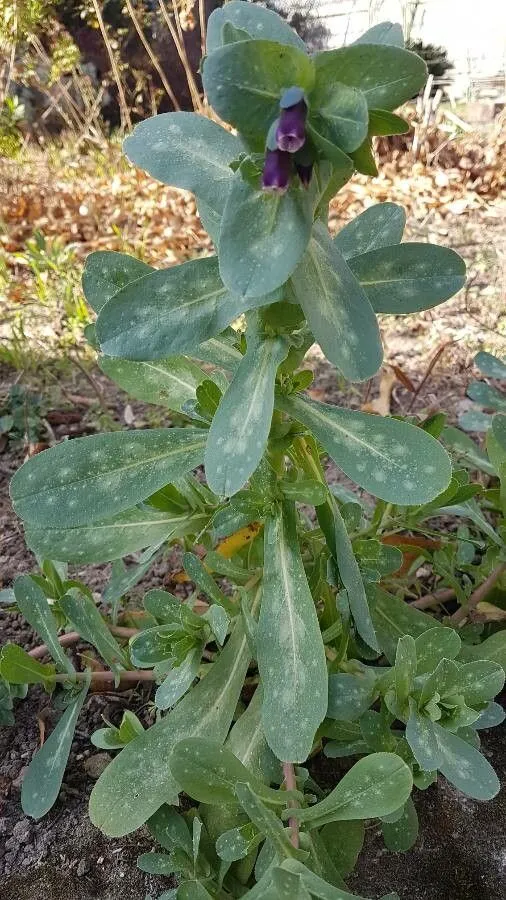
Author: L.
Bibliography: Sp. Pl.: 136 (1753)
Year: 1753
Status: accepted
Rank: species
Genus: Cerinthe
Vegetable: False
Observations: Medit.
Greater honeywort, scientifically known as Cerinthe major, is a notable plant first documented in 1753. As a member of the Boraginaceae family, it shares many characteristics typical of this group, while also boasting some unique features. With its native roots traced back to the Mediterranean region, this plant has adapted well to various climates and landscapes, enhancing garden diversity wherever it is planted.
Cerinthe major is esteemed for its striking aesthetic appeal. Its vivid tubular flowers, often showcasing a gradient of hues ranging from deep purples and blues to yellows and whites, make it a vibrant addition to any garden. The foliage complements the flowers beautifully, with broad, fleshy leaves that are often tinged with a delicate bluish-grey, adding to the plant’s overall ornamental value.
Apart from its visual appeal, Greater honeywort is also valued for its robustness. It is relatively easy to grow and care for, making it an excellent choice for gardeners seeking both beauty and low maintenance. It thrives in well-drained soils and sunny positions, though it is versatile enough to cope with partial shade. This adaptability means it can grace a variety of settings, from cottage gardens and wildflower meadows to contemporary landscape designs.
Gardeners and horticulturists appreciate Cerinthe major not just for its beauty and ease of cultivation but also for its ecological benefits. The plant is a magnet for pollinators, especially bees, which are drawn to the nectar-rich flowers. By attracting bees and other beneficial insects, Greater honeywort helps to support the local ecosystem, promoting the health and vitality of the garden environment.
In summary, Cerinthe major stands out as a horticultural gem. Its captivating appearance, coupled with its hardiness and ecological contributions, makes it a valuable addition to any plant collection. Whether used to add splashes of color or to allure pollinators, Greater honeywort remains a cherished plant for both its aesthetic and environmental benefits.
Deu: große wachsblume
Dan: stor voksurt
Fra: grand mélinet
Eng: great honeywort, greater honeywort, honeywort, blue shrimp plant
Lav: liel
Swe: stor vaxblomma
Nld: groot wasbloempje
En: Greater honeywort, Great honeywort, Honeywort, Blue shrimp plant
Be: Васкакветнік вялікі
Cs: Voskovka větší
Da: Stor Voksurt
Nl: Groot wasbloempje
Fi: Isovahakukka
Fr: Grand mélinet, Grand Cérinthe
De: Große Wachsblume, Groβe Wachsblume
It: Erba-tortora, Erba-vajola maggiore, Scarlattina, Succiamele, Cerinta glabra
Lv: Liel
Lt: Didžioji cerintė
Pt: Chupa-mel-roxo
Ru: Восковник большой
Sk: Voskovka väčšia, Voskovka menšia pravá
Es: Cerifllor, Ceriflor, Escarapela, Palomera
Sv: Stor vaxblomma
© copyright of the Board of Trustees of the Royal Botanic Gardens, Kew.
© copyright of the Board of Trustees of the Royal Botanic Gardens, Kew.
© copyright of the Board of Trustees of the Royal Botanic Gardens, Kew.
Taken Mar 21, 2019 by Antonio Pérez (cc-by-sa)
Taken Mar 11, 2022 by Florent Portalez (cc-by-sa)
Taken Apr 25, 2021 by jean Vale (cc-by-sa)
Taken Apr 22, 2021 by Jacques Zuber (cc-by-sa)
Taken Jan 28, 2019 by Osetya Polat (cc-by-sa)
Taken Apr 18, 2018 by penna (cc-by-sa)
Taken Feb 20, 2022 by clemence (cc-by-sa)
Taken Mar 11, 2022 by Florent Portalez (cc-by-sa)
Taken Apr 22, 2021 by Jacques Zuber (cc-by-sa)
Taken Feb 12, 2022 by Lugifa Lugifa (cc-by-sa)
Taken Apr 22, 2021 by Jacques Zuber (cc-by-sa)
Taken Sep 14, 2021 by David Hocken (cc-by-sa)
Taken Feb 9, 2022 by perez angelica (cc-by-sa)
Taken Mar 11, 2022 by Florent Portalez (cc-by-sa)
Taken Feb 24, 2019 by José Manuel Bustillos (cc-by-sa)
Taken May 13, 2020 by Oyinòdòdó K (cc-by-sa)
Taken Apr 24, 2022 by trees flinkerbusch (cc-by-sa)
Taken Apr 4, 2019 by robin (cc-by-sa)
Taken Jan 1, 1800 by Tela Botanica − Thierry Pernot (cc-by-sa)
Taken Feb 25, 2017 by Eric Rebsamen (cc-by-sa)
Taken Apr 27, 2015 by Manuel Hernández (cc-by-sa)
Taken Aug 15, 2018 by Jean Maurice Bauné (cc-by-sa)
Taken Aug 15, 2014 by Photoflora – Benoit BOCK (©)
Taken Apr 18, 2013 by Tela Botanica − Yoan MARTIN (cc-by-sa)
Taken Mar 22, 2015 by Tela Botanica − Paul FABRE (cc-by-sa)
Taken Apr 15, 2009 by Photoflora – Benoit BOCK (©)
Taken Apr 15, 2007 by Photoflora – Benoit BOCK (©)
Taken Aug 15, 2014 by Photoflora – Benoit BOCK (©)
Taken Aug 15, 2014 by Photoflora – Benoit BOCK (©)
Taken Mar 26, 2021 by Elena Profetto (cc-by-sa)
Growth habit: Forb/herb
Ph maximum: 7.5
Ph minimum: 7.0
Light: 7
Atmospheric humidity: 3
Soil nutriments: 5
Family: Myrtaceae Author: (F.Muell.) K.D.Hill & L.A.S.Johnson Bibliography: Telopea 6: 402 (1995) Year: 1995 Status:…
Family: Rubiaceae Author: Pierre ex A.Froehner Bibliography: Notizbl. Bot. Gart. Berlin-Dahlem 1: 237 (1897) Year:…
Family: Sapindaceae Author: Koidz. Bibliography: J. Coll. Sci. Imp. Univ. Tokyo 32(1): 38 (1911) Year:…
Family: Asteraceae Author: A.Gray Bibliography: Pacif. Railr. Rep.: 107 (1857) Year: 1857 Status: accepted Rank:…
Family: Fabaceae Author: Medik. Bibliography: Vorles. Churpfälz. Phys.-Ökon. Ges. 2: 398 (1787) Year: 1787 Status:…
Family: Aspleniaceae Author: (Cav.) Alston Bibliography: Bull. Misc. Inform. Kew 1932: 309 (1932) Year: 1932…